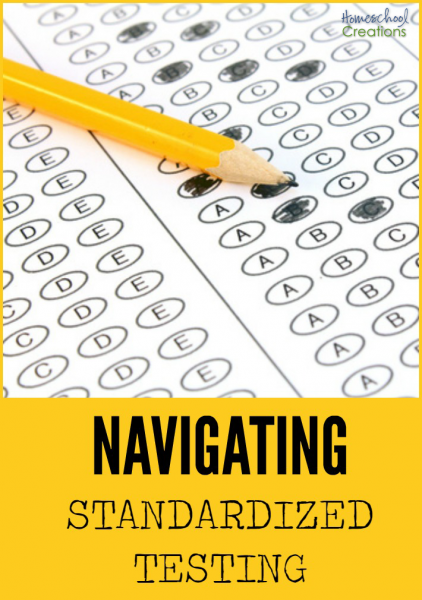- Like
- Digg
- Del
- Tumblr
- VKontakte
- Buffer
- Love This
- Odnoklassniki
- Meneame
- Blogger
- Amazon
- Yahoo Mail
- Gmail
- AOL
- Newsvine
- HackerNews
- Evernote
- MySpace
- Mail.ru
- Viadeo
- Line
- Comments
- Yummly
- SMS
- Viber
- Telegram
- Subscribe
- Skype
- Facebook Messenger
- Kakao
- LiveJournal
- Yammer
- Edgar
- Fintel
- Mix
- Instapaper
- Copy Link


(This post is an updated version of an earlier post, but one that definitely hasn’t lost its value over the years. With our standardized testing period coming up in May, I wanted to revisit some tips for navigating homeschool standardized testing.)
Pages of unfilled little circles can seem overwhelming. For many homeschool families, the words ‘standardized testing’ might strike a chord of fear. Although the tests are intended for the students, they can be a bit of a challenge for the parents as well.
Homeschool standardized testing was something that scared me to death at first. I was worried that our children would somehow massively fail the test and red flags would begin going up all over the county school offices and our children would be brought in for further evaluation. {For the record, that didn’t happen – grins}.
We live in a state where one of our yearly assessment options is submitting results from a standardized test beginning in the first grade. After reviewing the different testing options, we elected to use the IOWA test – it wasn’t as intense as some tests, but also covered a bit more than some other tests we reviewed. For consistency, we have used the same test each year to gauge our children’s progress. While our state only requires us to submit test results for three specific areas, we work on the entire test.
Are You Required to Use Standardized Tests?
Some states require yearly testing starting with younger children, other allow more relaxed testing standards, and other states require no testing at all. Remember that testing requirements vary from state to state, so be sure to check your state laws and know what is required from you and your children {check HSLDA for current information}.
There may be options for end of the year assessment other than standardized testing that can include a yearly portfolio, assessment by a certified teacher, etc. Again – know your state laws and do what you feel is right for your family based on the options available in your state.
For additional help, be sure to visit this post: Know the Homeschool Laws of Your State.
The Process of Standardized Testing
Choose a test that works for your family. Once you have determined the type of testing that is required for your state, you’ll need to find a test that will work for your family. Things to consider when choosing a test: Are you able to be the test administrator? What is the cost of the test? What areas are you required to test?
There are a multitude available, and below you’ll find a quick link to several of the most common test choices. Tests are available to order through various companies, so be sure to look around before deciding on the vendor.
-
IOWA Assessment Tests
-
Stanford Achievement Test
-
California Achievement Test {CAT}
-
Comprehensive Test of Basic Skills {CTBS}
- Peabody Individual Test (PIAT)
HSLDA has a great resource page for families listing various testing choices as well as vendors that carry various tests.
Administer the test. Depending on the test you choose to use with your child, you may be able to administer the test yourself {be sure to get certified in plenty of time before the tests}. Some tests will allow you as the parent to test your child, while other require someone else do the testing for you. In our area there are private schools that will administer the test for a fee.
Testing time usually take 2-3 hours a day over the course of several days. Depending on your child, you may be able to squeeze more into a day. Our older children are now at the point where they don’t want to drag it out, and they request to get it done over the course of 1-2 days.
For some great test taking tips, be sure to check out this article from HSLDA: 7 Test Taking Skills to Teach Your Child
Return completed test. Once the testing period is completed, you’ll need to gather your testing materials and return the test and any additional testing materials to the vendor for grading. We typically send our results via certified mail so that we can verify they were received by the vendor.
Interpret and submit testing results. Trying to decipher all the numbers and norms can be a bit tricky. Here are a few articles to help you navigate the number maze:
- Comparing Test Scores – Your Student’s and Norm’s
- Navigating Testing Norms
- Test Scores are Here – Now What?
Tips for Standardized Testing
Take a deep breath. As much as I worry about my kids and how they will do, they have always performed MUCH higher than the required norms. In addition, it has also helped me see areas that may need more attention from year to year (specific areas in math or language) and been an encouragement when they master and make dramatic improvements in those areas subsequent years.
Be prepared! Spend some time the week before you begin testing reviewing the materials yourself {if you are the administrator} and preparing your child for what is coming.
Choose a testing environment that works for you. While some of your children may do well with lots of noise and action going on around them, quiet may be needed. You know your child better than anyone, so be sure to remove any distractions from the testing area {maybe a pet is a favorite distraction or your child is distracted by external noises}.
We’ve had different scenarios each year, but typically try to find a quiet spot away from other children to work on testing. There have been years we’ve had additional help {i.e. I tested a friend’s child while she watched my other ones} or we’ve had a fun movie marathon for the other kids to ensure some quiet time for testing.
Have lots of pencils, erasers, and necessary tools on hand. While super sharp pencils are wonderful, slightly dull pencils work a bit better to fill in those circles. Inevitably our children manage to break numerous pencils, so we keep a supply on hand along with the large erasers to help with any mistakes.
Some tests may allow for scratch paper or calculators, so be sure everything is in place before you begin. That way you won’t need to go scrounging for things at the last minute.
Take lots of breaks and make it fun. Before testing begins, I pull out snacks {as well as a few fun treats} and plan some break activities for the testee so s/he is ready to go. Every few sections of testing we take a quick break to grab a quick treat, take a bathroom break if needed, and then get back to work. After a good chunk of testing has been completed, we take a fun break to play Wii or something similar.
Hint: Be sure to avoid snacks that are messy and/or greasy – they could stain testing materials!
Get plenty of rest the night before. This pretty much goes without saying, but sleep {or lack thereof} can make a big difference in how your child will perform on the test. Don’t forget that mom needs to get some rest too!
Watch your attitude. This is just a test. If you are showing anxiety or hovering over your child, it can affect how your child responds to the test. We have one child who gets very emotional when she doesn’t fully comprehend something that is being asked on the test. Before testing I always remind our children that they do not have to score perfectly, know every answer – and it is ok if they don’t! They just need to do the best that they can.
CELEBRATE!! Our testing time typically marks the end of our school year – take a night to celebrate with an ice cream party, a special dinner out, or something unique to your family. Make it a night to remember!
Things to Remember for Before and After Standardized Testing
-
Know your state’s deadlines for turning in testing results. Our school district has a date for submitting testing results that differs from a few other key dates we need to remember {submitting our letter of intent, etc…}.
-
Leave ample time for test taking, returning the tests and receiving test results. Typically turnaround time is between 6 to 8 weeks, depending on the time of year that you test. Be sure to order and schedule your testing and leave yourself some wiggle room for sick kiddos so the testing results will be received in time to submit them to the appropriate offices.
-
Keep a copy of the testing results on file for your records. Several years ago we switched school districts and the school district we moved from refused to forward any of our testing and school records on file to the new district. Every year I made duplicate copies of the letters and testing results that were submitted, so I was able to quickly copy those and mail them in.
How Much Does Standardized Testing Cost?
If you are administering your own test, you can expect to pay between $20 to $50 on average. Some families choose to have someone else proctor the test, which can add an additional fee. The cost will vary based on the test that your family chooses to use for testing and also on the age/grade level of your child.
For example, we use the IOWA test {ordered from BJU Press} which actually dropped in price for our older children this past year. Part of this is due to the materials that are provided for testing. Because I am able to administer the test to our children, we do not pay any other fees other than return mailing to the company for scoring.
Keep Your Perspective
Standardized testing is simply a tool to assess your child’s progress. This isn’t a pass or fail test. For our family it has been a way to also look at the homeschool goals that we set at the beginning of the year and compare how those areas match up with what they were tested on. There have been years where one child has struggled in certain areas, and then the next year that child improved remarkably.
Remember that standardized testing is only a ‘snapshot’ of the progress your child is making. There is so much more to your school year than what is summed up in a few pages of a test!
Does your state require testing? What test has your family used for standardized testing? Do you have a helpful tip to help make standardized testing easier? Leave a comment and share!
This post is a part of the Homeschool Basics series. Be sure to read the other posts if you are just joining in. For the record, I am not an expert. I’m a homeschool mom who is sharing what she’s learned so far along the way with her own family.








 The printables shared on this site are FREE of charge unless otherwise noted, and you are welcome to download them for your personal and/or classroom use only. However, free or purchased printables are NOT to be reproduced, hosted, sold, shared, or stored on any other website or electronic retrieval system (such as Scribd or Google docs). My printables are copyright protected and I appreciate your help in keeping them that way.
If you download and use some of my printables and then blog about them, please provide a link back to my blog and let me know - I'd love to see how you are using them! Please be sure to link to the blog post or web page and not directly to the file itself. Thank you!
The printables shared on this site are FREE of charge unless otherwise noted, and you are welcome to download them for your personal and/or classroom use only. However, free or purchased printables are NOT to be reproduced, hosted, sold, shared, or stored on any other website or electronic retrieval system (such as Scribd or Google docs). My printables are copyright protected and I appreciate your help in keeping them that way.
If you download and use some of my printables and then blog about them, please provide a link back to my blog and let me know - I'd love to see how you are using them! Please be sure to link to the blog post or web page and not directly to the file itself. Thank you!
We currently don’t have to do any testing. Do you think it would be good to take these test anyways? Thanks for all your help.
We do Spectrum test practice each year though.
Our state offers several different options, testing being one of them. I am also certified to sign off on our kids because I have an MEd, but my hubby and I still opt to do the standardized testing route – only because the state can also push back and not accept the sign-off. The testing is essentially to cover us in case there is an issue. We’ve more recently switched to the CAT from the IOWA, which is a little less intense, but will still give an overall view of how they are doing and if there are any gaps. I like the ‘lesser’ option because I know the testing stresses them out. :)